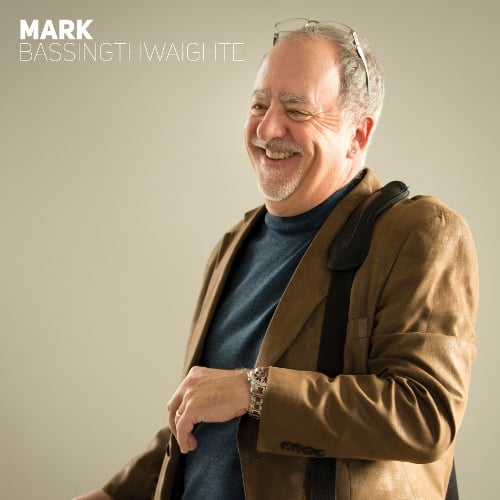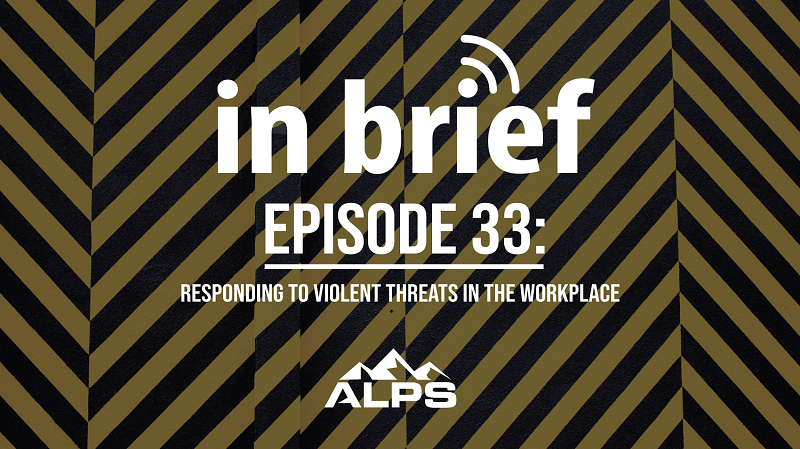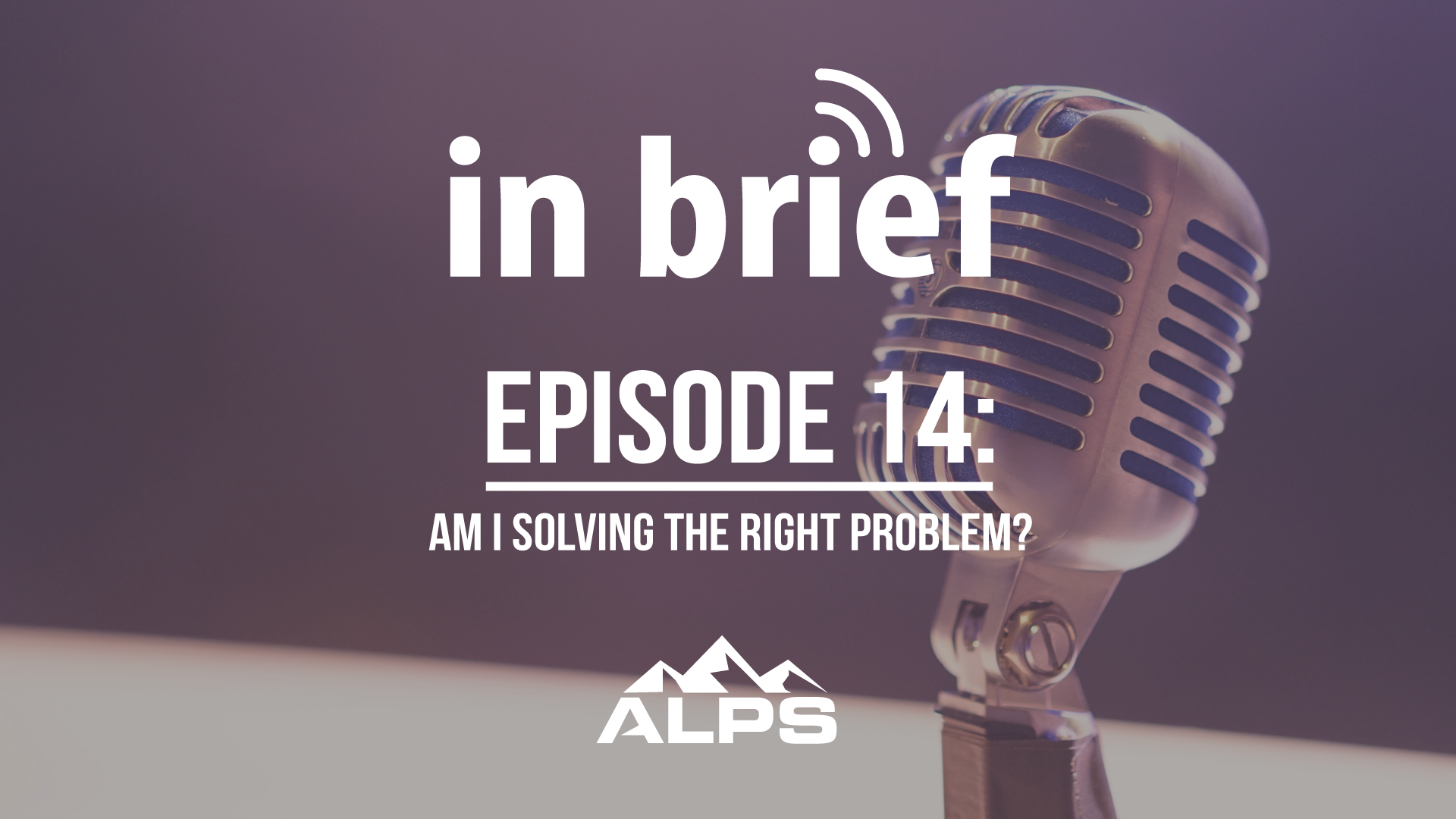Active shootings can happen anywhere, even in law firms. What can attorneys and their staff do to prepare and protect each other in these kinds of scenarios? Mark sits down with active-shooter response expert, retired U.S. army sniper, and Montana-licensed attorney Alain Burrese to discuss law firm safety tactics and active shooter protocol.
Transcript:
MARK B:
Good morning podcast listeners. What a beautiful day here in Montana, and welcome to the latest episode of ALPS In Brief, the podcast that comes to you from the historic Florence building in beautiful downtown Missoula, Montana. I’m Mark Bassingthwaighte, the Risk Manager here with ALPS, and today I am most excited to have as a guest Alain Burrese. Alain is quite a guy; we’ve had — I should say, I have had — the privilege and pleasure to work with him a number of years ago. In fact, Alain, if you recall, we had an experience in Las Vegas (for work), but we had a lot of fun doing some consulting down there. The topic that Alain and I are going to discuss today is really, in my mind, a very, very important topic. Also one that I wish we didn’t have to talk about, but in this day and age we do, and it’s looking at active shooting situations.
Before we get into this, let me tell you a little bit about Alain. Alain is a former U.S. Army sniper and sniper instructor at the 2nd Infantry Division scout sniper school at Camp Casey, South Korea, a former U.S. Army paratrooper with the 82nd Airborne Division out of Fort Bragg, fifth degree black belt, [inaudible 00:01:29] instructor, author and producer of numerous books and DVDs on self defense, to include, Survive a Shooting: Lifesaving Tactics and Strategies to Survive Active Shooters and Other Terrorist Attacks. And I could just go on and on. He’s a certified active shooter instructor, has trained more than 4,000 people, and on top of all that, if that’s not enough, he’s a licensed attorney here in the state of Montana. So Alain, it is such a pleasure to have you join us.
ALAIN:
It’s a pleasure to be here with you, Mark, and I have fond memories of our trip to Vegas too and we’re down there helping a bunch of law firms be safe in a different kind of environment when we are down there.
MARK:
Yes, that’s absolutely true. Risk management and best practice, those kinds of things, a little less emotionally tense.
Alain, I really wanted to talk with you because as you and I, and I’m sure everybody in our listening audience is well aware of, there have been in recent times quite a number of mass shooting situations that have made the news, not only nationwide but some of these certainly worldwide. What people don’t hear as much is the shootings that are smaller scale, perhaps. It’s not commonplace, thankfully, but in this day and age there are occasionally shootings that occur in even small law firms. Disgruntled … client or an adverse party, you know, can come in at times. You’ll see these occasionally in a divorce situation, and it can be anything. So I do think it’s, it’s worth talking about active shooting scenarios.
These small situations, again, they don’t make the national news, but we certainly, we’ve had an occasional situation like this pop up in our own book. You read some of these in the journals, in terms of, [inaudible 00:03:32] Journal and some of our industry publications. But Alain, where I wanna start, are there really things that attorneys can do, or staff, to survive these kinds of shootings? If I’m sitting in reception or an associate of law firm or something, can I realistically do anything?
ALAIN:
Mark, there are a lot of things we can do. It’s interesting that you talk about law firms and the active shooters. We have the big active shooter events, and most definitions of active shooter is somebody that’s just trying to kill random innocent people with no other crime. But we have a lot more shooting incidents where that could be a gang affiliated, where people shooting each other for gang related drug related issues. But we also do have a lot of shootings and attacks, sometimes it could be with a knife or something else, that are more directed, and law firms could be a very good target for that. Like you said you have disgruntled clients, something went south, and especially domestic issues, and something didn’t go the way they wanted it to and the attorney is to blame. So they’re going to come in specifically to attack that person or maybe that person’s staff or maybe the entire office cause they blame everybody there. [crosstalk 00:05:02] There are things we can do to increase the law firm safety and to decrease the amount of damage a potential person like that could inflict on people.
MARK:
Well Alain, let’s start perhaps with prevention, are there steps that we can take in anticipation that something like this might happen?
ALAIN:
One is recognizing signs. Awareness, and I teach awareness in all of my programs, is number one. And being aware of that potential former client, current client employee, that maybe is something wrong with that employee. Maybe just a former employee because they were fired, recognizing some signs that something’s not going on right with that person. And those signs could be a depression, the significant event the life, which a lot of things involved in law offices are very significant to people’s lives. It could be a fascination with weapons or explosives.
So if you’re seeing something that’s just not normal with a person … we’re here in Montana, a guy goes and buys a new hunting rifle, big deal. Everybody has firearms up here in Montana. But if there’s this weird fascination that’s just not normal, and we sort of know what baseline normal is for our environments, maybe that person needs to be watched a little close. Ideally, we can get people help before something bad happens. Remember the national news a couple of years ago with his father that found the daughter’s diary and then ended up turning her in and thankfully they were able to get that young lady some help before she did what she was writing about in the diary, which was going to kill a lot of people.
MARK:
Yeah, that’s a great point. I mean I’m here, I love it, Alain. And since I’m already learning all kinds of stuff. I never even stopped to think about- awareness obviously, very, very important, but you’re identifying potential shooters, people that are going to- can go make some very, very wrong decisions, that I wasn’t even thinking about in this context. That is really good stuff. So awareness becomes, it sounds like, a key thing to keep in mind from a preventative standpoint. Are there any other kinds of things or is that pretty much the-
ALAIN:
How you have your facility laid out. One way in, having controlled access to places helps prevent these things. So if there’s only one way in, and it’s monitored somehow, that’s a little bit better than people can come and go in a lot of different places. Having a communication system set up. Somebody comes in the front door that’s bad, is wrong, can that be communicated to people throughout the office? Having ways to lock down, so people can lock down their offices and stay safe in rooms. Being prepared with- some people are gonna keep firearms in their office, that that is an option. If you do that, I hope that you have the proper training in both safety and use of the weapon that you have.
I teach fire extinguishers as improvised weapons, because they’re in almost every building, any public building we’re going to find fire extinguishers. Reflex Protect is a great nonlethal option that people are starting to use. And then knowing where your exits are for you to be able to escape. Cause your basic things that you can do is you can escape, you can barricade and lock that person from getting to you, or you can defend yourself by physically attacking back and stopping that shooter. Those are your three options if a situation actually happens. So being prepared to do any of those and all of those is what you want in your plan.
MARK:
Yeah. It’s been interesting, with the consulting work over the years, I have gone into law firms that sometimes have key card access or a doorbell, and they have to, you know, see on camera before they push a little button that lets you in. So there are firms that have taken these kinds of steps already. Let’s talk about these three options that you’ve identified. Whether it’s, somebody that has pulled out a knife, somebody that has come in with a gun and is threatening. If you will, when the bullets are flying, can we take a little further this discussion about what, what do we do as individuals to try to survive this? You talk for instance about escape versus attacking and trying to defend. I would assume that, I guess I’d say, how do you evaluate in these kinds of settings what your best option is?
ALAIN:
Sure. In the programs I teach, I put those in a triangle, with each, “Escape, deny, and defend,” the points of the triangle, versus the linear “Run, hide, fight,” which is the national program. Because it’s not all linear. You can’t say, well first I will escape. If I can’t escape, I will deny. If I can’t deny, then I will defend myself. You don’t always have those options.
Say we’re in a big meeting room. If I’m in the very back of the room beside a door and someone comes in the opposite end of the room through that door, I could probably escape out this back door. If I’m the person sitting closest to that front door where the person comes in, I don’t have that option anymore. So you’re going to immediately go to defending yourself and try to take that guy out. So that’s why it’s sort of a triangle. You have to do one of the three, but which one you do will be determined by where you’re at in location to the threat, what the threat has, your environment. All of those factors are going to come into play of which is going to be the best.
MARK:
Okay, sometimes-
ALAIN:
Of course-
Go ahead.
MARK:
Well I see. Can we talk about each of these individually? You talk about, okay, so my first and best choice if using the conference room situation, I can try to escape because that’s the easiest, fastest thing to do, and safest, at least for me as I’m hearing. Does escape always mean find the closest exit, for lack of a better word, and just run, just go for it? Is that-
ALAIN:
Often, that is. Getting out of the kill zone. Now it could be running away. It could be going out a window and running. It could be dropping down and crawling behind something until you get a place to run. But getting out of the kill zone, and as far away as possible. If you can do that, great. But sometimes that’s not an option. You might be a caretaker of somebody or be with somebody that can’t escape with you. So again, it is a great option if available.
MARK:
This whole conference room example, and thank you for bringing it up, it just brings so many kinds of ethical dilemmas in my mind, which is, what we’re all about here. I’m always writing and trying to talk in a lecture on ethics. Is there, what are your thoughts ALAIN, about, I am the guy getting closest to the door, but I’m a senior partner, and I have staff and colleagues and things that are more in between. Is always the best answer for me to try to escape, or is there, do I try to help as many others escape, too? You see what I’m trying to get at and-
ALAIN:
That that is going to vary from individual to individual. I know that if I was on a job working security, my reaction would probably be different than if I was at the mall and a situation happened and I was with my wife and daughter, and would be different if I was alone. There are some people that are natural, to use David Grossman’s term, sheep dogs, the protectors. They’re going to try to help other people and stop threats. Not everyone has that inside them, so I’m not going to fault anybody because they escaped and didn’t help others. It’s inside certain people.
I think some of us, though, are going to help more and that’s just the nature of us. I would like everyone to help everyone else, but we know that that’s not always going to be the case. If you’re the closest person to the threat, whether it’s a knife, a shooter, whatever, probably the option is, you’re going to be the one that has to fight. If not, you’re probably going to die. Sad as it is, I can’t give you strategies to keep everyone alive. In these situations, people will get hurt and people will die, but we can reduce the number of people that are killed.
MARK:
Let’s talk about that then. I think I’m pretty confident in saying it’s the other two angles, or corners of your triangle here. Escape may or may not be an option, one or two get out. This other corner is “deny”. So even if I, I think school shootings are a great example, perhaps where a teacher could deny access in some fashion, which is where I think we’re going here, to try to protect the 30 students in her room or his room. Can we explore, what does “deny” mean, and how, particularly in the context of a small business like a law office, what are your thoughts about, how do we do that?
ALAIN:
It can be as simple as locking a door and keeping that person out through a good solid locked door. It can be barricading. It can be getting behind some type of cover, cover being something that will stop bullets where concealment might hide you, but it doesn’t stop bullets. Something that will deny that person ability to hurt you. Now, with a knife wielding subject, picking up a chair and holding that chair between you and that person so he can’t get close enough to cut you, is a way to deny him access from hurting you. So different weapons, different threats, there are different ways to deny that threat from hurting you.
MARK:
Great. Again, I’m always learning something from you, ALAIN. I never even would have thought, hey, let’s just pick up a chair. What a great example. Okay, I like that.
When I think about bad actors, I always have in my mind that these people are experienced and understand how to use a weapon, and that that may or may not be true. But I look at somebody like myself and I’ll say, honestly, I’ve had one opportunity in my life where I’ve gone to a shooting range and had somebody give me a little experience in how to fire a hand gun. So I’ve done that for probably 45 minutes in my whole life. Trust me, I am not trained, obviously, to handle weapons. So it seems to me that I would be, for lack of a better description, out of my league. I don’t know how to respond. Does that mean that I really should never try to attack? Does it mean I’m completely screwed for lack of- what can I do? I’m untrained and I’m against somebody that may or may not have real skillsets with the weapons they have brought to the table here. So is there something an average person like myself could do, if I’m forced into no other option?
ALAIN:
There a couple things. One of the things, empty handed- I don’t teach anybody to go straight on against a shooter or a knife welder and take the gun or take the knife away from the person. That’s not realistic. However, from the sides or behind, you can, and lot of times what I teach is if you have a group, the first guy grabs the arm and the weapon and just forces it to the ground while the couple people behind tackle the guy, and you just sort of swarm and jump on top of him and pound on him until you have the gun or the knife or whatever away from him.
That has been successful. People have done that and stopped people. But we also, one of the reasons that’s why I joined Reflex Protect, is that gives a nonlethal response, because you can spray the guy in the face from ten, fifteen, twenty feet away, and that stuff gets in the eyes, it starts burning, it’s going to stop the threat. If you can spray a Windex bottle, you know, or whatever wasp spray kind of thing, you can spray Reflex Protect. It’s so easy and it gives you a nonlethal option as well for untrained people.
MARK:
Okay. I also liked your earlier comment of just the, the fire extinguisher. Never would have thought of that either.
ALAIN:
Fire extinguishers are good. And all of these, I like to teach, where you’re going to ambush the bad guy at a doorway or at a corner, coming from the side, coming from the rear, rather than a head on, straight on to a person that’s armed.
MARK:
Okay. This situation plays out in whatever way it plays out, and I’m going to assume that we have somebody if not more, that’s wounded and or has been killed. What happens next? The attack is over, the attacker has run, the attacker has been mobbed and is on the ground. We’ve got the guy. What’s next?
ALAIN:
Couple things. One, it’s important that everyone has some basic first aid training, and there’s new programs called Stop the Bleed. It’s a national program. We have instructors here in Missoula. Actually, I’m going to be a certified instructor here pretty soon with Stop the Bleed, just increase my knowledge, and then having some supplies on hand,. Having a medical kit that also has tourniquets, pressure bandages, that could stop severe bleeding. That’s a good thing to have in your car and have individually, too. Not just for shooters or people with knives, car accidents, anything that’s massive hemorrhaging, you can save a life if you can stop that bleeding. Having tourniquets, pressure bandages, things available, and people that know how to use them, can save lives.
MARK:
Is that the most important thing that you can do then, to save somebody who’s been shot or injured? Is that what you’re getting to?
ALAIN:
Usually, yes. If it’s a chest, you’re gonna need a chest seal. If it punctured a lung, that sucking chest wound. So that would be good to have in your kit as well. But from bullets, if it’s in the limbs, it’s probably, you’re going to die of hemorrhaging if you don’t stop the bleeding. In the chest, if it’s a sucking chest wound, you’re going to need that. Elsewhere in the torso, stuffing the wound, wrapping it, controlling the bleeding until the professionals get there. Because if they’re not dead already, if they’re alive, it’s the loss of blood that’s most likely to kill them. So stopping bleeding, treating for shock until the professionals take over, gives you the best options of saving lives.
MARK:
Obviously the professionals are going to show up, in terms of emergency personnel and the police. Is there anything that we need to know in terms of, what do we do or not do with- I’m particularly thinking about police, in terms of interacting with them. Any thoughts about that?
ALAIN:
Make sure- it’s going to be chaotic for you. It’s going to be chaotic for them. So make sure you are not mistaken for a threat. If you do have a firearm, it should be put away or put down and not in your hands. Whether that’s your own, or one you took away from the bad guy. You want to be able to show open hands when the law enforcement shows up, so they don’t mistake you.
I’ll say this about Reflex Protect, too, because it looks, and it fires, it has a head on it that’s like a firearm, sort of a trigger mechanism, I want to put that down, too, because law officers, they don’t know what’s in your hands unless they’re empty, and that’s what they want to see. Listen to them, do what you’re told. They may treat everyone as a bad guy until they know for sure … don’t get offended, that’s part of their job. Just listen to them. Do what you’re told until the situation’s over.
MARK:
Okay. I should have brought this up a little bit earlier, talking about Reflex Protect here, and just for our listeners, out of Montana anyway. We’re in bear country here and do a lot of hiking and you may be aware of what we call bear spray, and people over the years carry these cans of bear spray out in the wilderness, and it’s sort of a wide field pepper spray and it can be very, very effective. But what you’re talking about Alain, if I understand it correctly, is we’ve kind of taken this technology or this approach up a step and this is a stream that you can target specific areas. The center of the face, as an example, and it’s a gel like product, but what we’re talking about is a nonlethal chemical device here that just tries to stop a person from attacking you. Am I describing it accurately?
ALAIN:
Exactly. It shoots out in the stream like wasp spray, and the benefit, it’s not pepper spray, which contaminates the entire room and every- if you’ve ever been in a room where they shoot pepper spray or even outside with bear spray, everybody in the area is gagging and coughing. This uses a CS based gel. It’s the Presidia Gel, with the active ingredient of CS. It only affects the bad guy, and nobody else in the room will be affected or contaminated, which makes it safe to be used inside of a hospital, inside of a school, inside of a church, inside of a law office, anywhere inside. It’s not going to have that affect that pepper spray has.
MARK:
Right. And just as an aside, a number of years ago when our kids were lot smaller, one of my boys found a can of pepper spray, and we had friends over for dinner and their kids and they’re all playing around, and he just later on looked like “Daddy. It just, the voice in my head said push the trigger and see what happens.” And he emptied a can of pepper spray in our family room. So I have firsthand experience with that, and it does impact everybody. And cleaning that up, ooh, what a mess.
Well, listen, Alain, it really has been a pleasure. Just, some great stuff that you’ve shared and I hope that we have some listeners here that really take it to heart. It seems to me there are things we can do, and I love just even being aware of what’s going on, and having the courage to try to find appropriate help if necessary. But before we go, I do want to give you a chance to share any closing thoughts. The floor is yours.
ALAIN:
Certainly. The most important thing is I want people to be aware and be safe. I wrote in my book that it’s the most important book I wish you didn’t need to read. And I wish I didn’t have to talk about this, but we saw just a little over a week ago, twelve people killed. Again, another shooting where 12 innocent people killed. So it is important to not be paranoid, but to have a plan to practice safe habits so you can enjoy life safely. Both at work, at home, and wherever else you are.
If you want more information, my book has been called one of the best on the topic, it’s over 350 pages of solid information to help you, and that’s at surviveashooting.com or amazon.com. And if you want a nonlethal way to defend yourself in your office or your home, reflexprotect.com, and you can learn a lot more about that product.
MARK:
Perfect. Thank you very much.
Well folks, for those of you listening, I hope you found something of value today. Boy, I sure did. Just great stuff. Again, I appreciate your listening, and if you have any thoughts, ideas, interests, in terms of topics or other folks you’d like to hear from, please don’t hesitate to reach out to me. You may email me at mbass@alpsnet.com.
So that’s it. Alain, thank you again. Folks, have a good day. Bye Bye.
—
ALAIN BURRESE is an author, safety speaker, and Hapkido/Self-defense instructor. He is a former paratrooper with the 82nd Airborne Division and Sniper Instructor with the 2nd Infantry Division.
ALPS In Brief Podcast Intro/Outro Music: Walk In The Park by Audionautix is licensed under a Creative Commons Attribution 4.0 license. https://creativecommons.org/licenses/by/4.0/
Artist: http://audionautix.com/



 Mark Bassingthwaighte, Risk Manager
Mark Bassingthwaighte, Risk Manager




